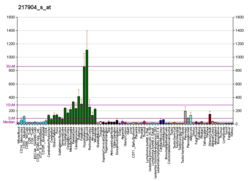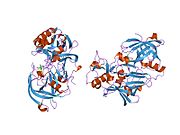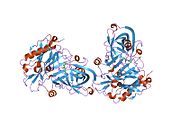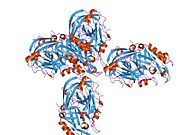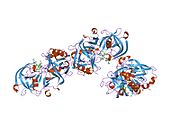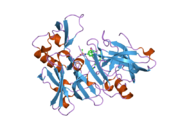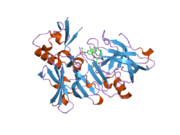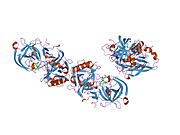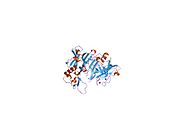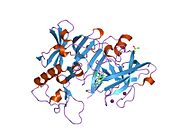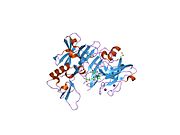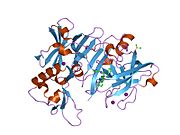Beta-secretase 1
Beta-secretase 1 (BACE1), also known as beta-site amyloid precursor protein cleaving enzyme 1, beta-site APP cleaving enzyme 1, membrane-associated aspartic protease 2, memapsin-2, aspartyl protease 2, and ASP2, is an enzyme that in humans is encoded by the BACE1 gene.[5]
BACE1 is an aspartic-acid protease important in the formation of myelin sheaths in peripheral nerve cells.[6] The transmembrane protein contains two active site aspartate residues in its extracellular protein domain and may function as a dimer.
Role in Alzheimer's disease

Generation of the 40 or 42 amino acid-long amyloid-β peptides that aggregate in the brain of Alzheimer's patients requires two sequential cleavages of the amyloid precursor protein (APP). Extracellular cleavage of APP by BACE1 creates a soluble extracellular fragment and a cell membrane-bound fragment referred to as C99. Cleavage of C99 within its transmembrane domain by γ-secretase releases the intracellular domain of APP and produces amyloid-β. Since gamma-secretase cleaves APP closer to the cell membrane than BACE1 does, it removes a fragment of the amyloid-β peptide. Initial cleavage of APP by α-secretase rather than BACE1 prevents eventual generation of amyloid-β.
Unlike APP and the presenilin proteins important in γ-secretase, no known mutations in the gene encoding BACE1 cause early-onset, familial Alzheimer's disease, which is a rare form of the disorder. However, levels of this enzyme have been shown to be elevated in the far more common late-onset sporadic Alzheimer's. The physiological purpose of BACE's cleavage of APP and other transmembrane proteins is unknown. BACE2 is a close homolog of BACE1 with no reported APP cleavage in vivo.
However a single residue mutation in APP reduces the ability of BACE1 to cleave it to produce amyloid-beta and reduces the risk of Alzheimers and other cognitive declines.[7][8]
BACE inhibitors
Drugs to block this enzyme (BACE inhibitors) in theory would prevent the buildup of beta-amyloid and may help slow or stop Alzheimers disease.
Several companies are in the early stages of development and testing of this potential class of treatment.[9][10] In March 2008 phase I results were reported for CoMentis Inc's candidate CTS-21166.[11]
In April 2012 Merck & Co., Inc reported phase I results for its candidate verubecestat (MK-8931).[12] Merck began a Phase II/III trial of MK-8931 in December, 2012 estimated to be completed in July 2019.[13] In September 2014 AstraZeneca and Eli Lilly and Company announced an agreement to codevelop AZD3293.[14] A pivotal Phase II/III clinical trial of AZD3293 started in late 2014 and is planned to recruit 1,500 patients and end in May 2019.[15]
Tests in mice have indicated that BACE proteases, specifically BACE1, are necessary for the proper function of muscle spindles.[16] These results raise the possibility that BACE inhibiting drugs currently being investigated for the treatment of Alzheimer's may have significant side effects related to impaired motor coordination,[citation needed] though BACE1 knockout mice are healthy.[17]
Relationship to plasmepsin
BACE1 is distantly related to the pathogenic aspartic-acid protease plasmepsin, which is a potential target for future anti-malarial drugs.[18]
References
- ^ a b c GRCh38: Ensembl release 89: ENSG00000186318 – Ensembl, May 2017
- ^ a b c GRCm38: Ensembl release 89: ENSMUSG00000032086 – Ensembl, May 2017
- ^ "Human PubMed Reference:". National Center for Biotechnology Information, U.S. National Library of Medicine.
- ^ "Mouse PubMed Reference:". National Center for Biotechnology Information, U.S. National Library of Medicine.
- ^ Vassar R, Bennett BD, Babu-Khan S, Kahn S, Mendiaz EA, Denis P, Teplow DB, Ross S, Amarante P, Loeloff R, Luo Y, Fisher S, Fuller J, Edenson S, Lile J, Jarosinski MA, Biere AL, Curran E, Burgess T, Louis JC, Collins F, Treanor J, Rogers G, Citron M (Oct 1999). "Beta-secretase cleavage of Alzheimer's amyloid precursor protein by the transmembrane aspartic protease BACE". Science. 286 (5440): 735–41. doi:10.1126/science.286.5440.735. PMID 10531052.
- ^ Willem M, Garratt AN, Novak B, Citron M, Kaufmann S, Rittger A, DeStrooper B, Saftig P, Birchmeier C, Haass C (Oct 2006). "Control of peripheral nerve myelination by the beta-secretase BACE1". Science. 314 (5799): 664–6. Bibcode:2006Sci...314..664W. doi:10.1126/science.1132341. PMID 16990514.
{{cite journal}}: Unknown parameter|laysource=ignored (help); Unknown parameter|layurl=ignored (help) - ^ "Alzheimer's-fighting gene may inspire treatments". July 2012.
- ^ Jonsson T, Atwal JK, Steinberg S, Snaedal J, Jonsson PV, Bjornsson S, Stefansson H, Sulem P, Gudbjartsson D, Maloney J, Hoyte K, Gustafson A, Liu Y, Lu Y, Bhangale T, Graham RR, Huttenlocher J, Bjornsdottir G, Andreassen OA, Jönsson EG, Palotie A, Behrens TW, Magnusson OT, Kong A, Thorsteinsdottir U, Watts RJ, Stefansson K (Aug 2012). "A mutation in APP protects against Alzheimer's disease and age-related cognitive decline". Nature. 488 (7409): 96–9. Bibcode:2012Natur.488...96J. doi:10.1038/nature11283. PMID 22801501.
- ^ Walker LC, Rosen RF (Jul 2006). "Alzheimer therapeutics-what after the cholinesterase inhibitors?". Age and Ageing. 35 (4): 332–5. doi:10.1093/ageing/afl009. PMID 16644763.
- ^ Baxter EW, Conway KA, Kennis L, Bischoff F, Mercken MH, Winter HL, Reynolds CH, Tounge BA, Luo C, Scott MK, Huang Y, Braeken M, Pieters SM, Berthelot DJ, Masure S, Bruinzeel WD, Jordan AD, Parker MH, Boyd RE, Qu J, Alexander RS, Brenneman DE, Reitz AB (Sep 2007). "2-Amino-3,4-dihydroquinazolines as inhibitors of BACE-1 (beta-site APP cleaving enzyme): Use of structure based design to convert a micromolar hit into a nanomolar lead". Journal of Medicinal Chemistry. 50 (18): 4261–4. doi:10.1021/jm0705408. PMID 17685503.
- ^ "CoMentis BACE Inhibitor Debuts". April 2008.
- ^ "Merck Presents Results of a Phase I Clinical Trial Evaluating Investigational BACE inhibitor MK-8931 at American Academy of Neurology". April 2012.
- ^ "Merck Initiates Phase II/III Study of Investigational BACE Inhibitor, MK-8931, for Treatment of Alzheimer's Disease". December 2012.
- ^ "AstraZeneca and Lilly announce alliance to develop and commercialise BACE inhibitor AZD3293 for Alzheimer's disease". 16 Sep 2014. Retrieved 8 Oct 2014.
- ^ "AstraZeneca and Lilly move Alzheimer's drug into big trial". December 2014.
- ^ Cheret, Cecil; Michael Willem; Florence R Fricker; Hagen Wende (June 2013). "Bace1 and Neuregulin-1 cooperate to control formation and maintenance of muscle spindles". European Molecular Biology Organization.
- ^ Roberds SL, Anderson J, Basi G, Bienkowski MJ, Branstetter DG, Chen KS, Freedman SB, Frigon NL, Games D, Hu K, Johnson-Wood K, Kappenman KE, Kawabe TT, Kola I, Kuehn R, Lee M, Liu W, Motter R, Nichols NF, Power M, Robertson DW, Schenk D, Schoor M, Shopp GM, Shuck ME, Sinha S, Svensson KA, Tatsuno G, Tintrup H, Wijsman J, Wright S, McConlogue L (Jun 2001). "BACE knockout mice are healthy despite lacking the primary beta-secretase activity in brain: implications for Alzheimer's disease therapeutics". Human Molecular Genetics. 10 (12): 1317–24. doi:10.1093/hmg/10.12.1317. PMID 11406613.
- ^ Russo I, Babbitt S, Muralidharan V, Butler T, Oksman A, Goldberg DE (Feb 2010). "Plasmepsin V licenses Plasmodium proteins for export into the host erythrocyte". Nature. 463 (7281): 632–6. Bibcode:2010Natur.463..632R. doi:10.1038/nature08726. PMC 2826791. PMID 20130644.
{{cite journal}}: Unknown parameter|laysource=ignored (help); Unknown parameter|layurl=ignored (help)
Further reading
- Hong L, He X, Huang X, Chang W, Tang J (2005). "Structural features of human memapsin 2 (beta-secretase) and their biological and pathological implications". Acta Biochimica et Biophysica Sinica. 36 (12): 787–92. doi:10.1093/abbs/36.12.787. PMID 15592644.
- Johnston JA, Liu WW, Todd SA, Coulson DT, Murphy S, Irvine GB, Passmore AP (2006). "Expression and activity of beta-site amyloid precursor protein cleaving enzyme in Alzheimer's disease". Biochemical Society Transactions. 33 (Pt 5): 1096–100. doi:10.1042/BST20051096. PMID 16246054.
- Dominguez DI, Hartmann D, De Strooper B (2006). "BACE1 and presenilin: two unusual aspartyl proteases involved in Alzheimer's disease". Neuro-Degenerative Diseases. 1 (4–5): 168–74. doi:10.1159/000080982. PMID 16908986.
- Zacchetti D, Chieregatti E, Bettegazzi B, Mihailovich M, Sousa VL, Grohovaz F, Meldolesi J (2007). "BACE1 expression and activity: relevance in Alzheimer's disease". Neuro-Degenerative Diseases. 4 (2–3): 117–26. doi:10.1159/000101836. PMID 17596706.
External links
- The MEROPS online database for peptidases and their inhibitors: A01.004
- beta-Secretase: Molecule of the Month, by David Goodsell, RCSB Protein Data Bank






